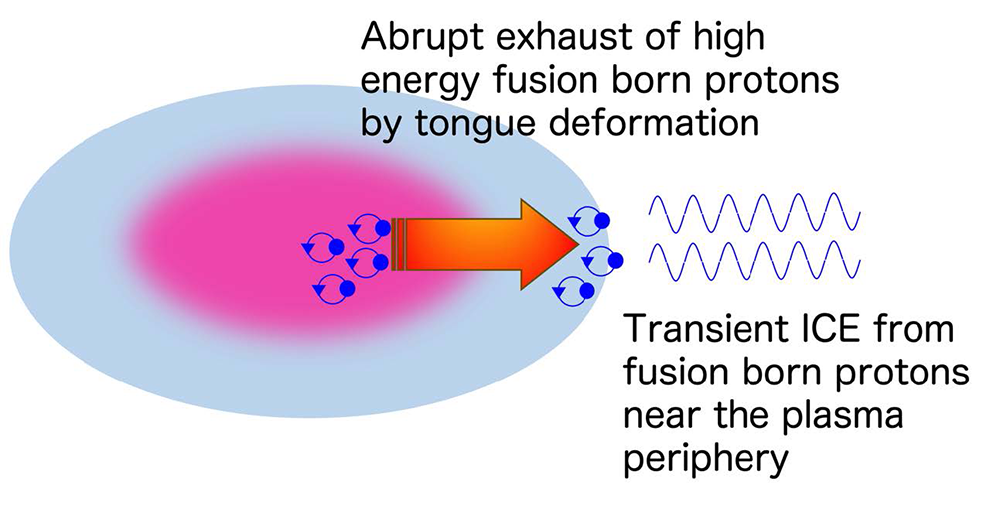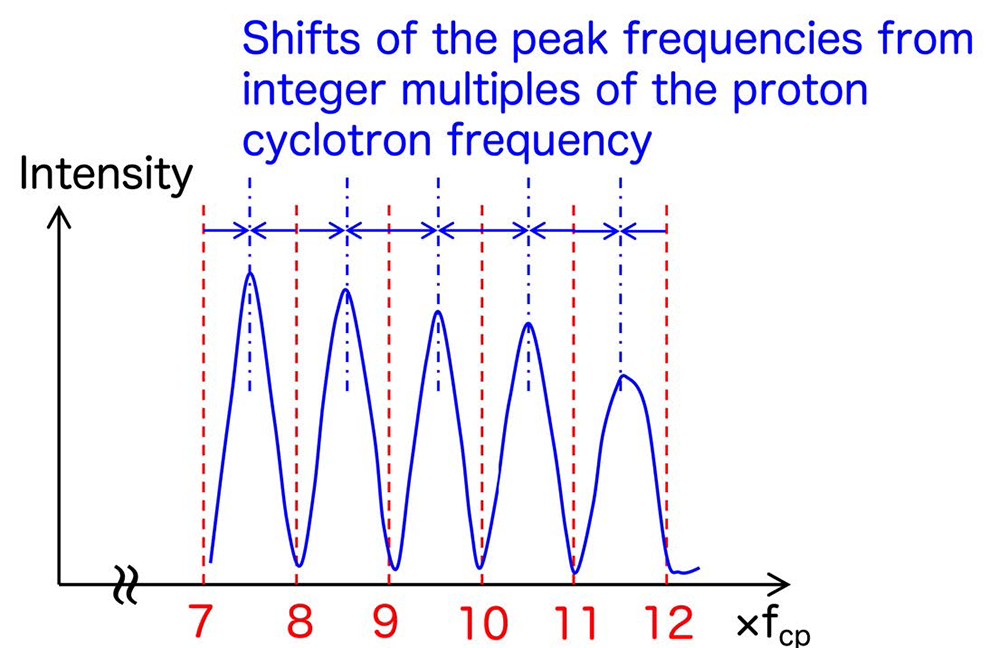First Observation of Ion Cyclotron Emission from fusion-born protons in a heliotron-stellarator plasma
In deuterium beam heated plasma at the LHD, ion cyclotron emission (ICE) from fusion-born protons has been observed for the first time in a heliotron-stellarator. The frequencies of the successive ICE spectral peaks shifted from a proton cyclotron harmonic frequency in the likely emitting region. First principles computations of the collective relaxation of this proton population were carried out using a particle-in-cell approach. We found substantial frequency shifts in the peaks of the simulated ICE spectra, which corresponded closely to the measurement.


In the Large Helical Device (LHD), high ion temperature plasma is generated by neutral deuterium beam injection. The abrupt local deformation of the confined magnetic field, called a “tongue”, which occurs near the neutral beam injected perpendicularly to the confined magnetic field, causes a magnetic reconnection and results in the exhausting of high energy ions. Energetic protons of 3.02 MeV and tritium ions of 1.01 MeV, which are rarely produced by deuterium-deuterium nuclear fusion, can be also exhausted from the plasma centre to its periphery by such abrupt tongue deformation (Fig. 1).
Generally, charged particles in magnetically confined plasma rotate around the magnetic filed line and emit electromagnetic or electrostatic waves. We call this phenomenon cyclotron emission. The rotating frequency is proportional to the magnetic field strength and is called cyclotron frequency. The frequency of the cyclotron emission shifts from integer multiples of the cyclotron frequency by a product of k∥ and v∥. Where k∥ is the parallel wave number of the emitted wave. This shift is called a “Doppler shift”.
The ion cyclotron emissions (ICE) typically consist of intense spectral peaks at cyclotron harmonics, due to the collisionless relaxation of an energetic ion species. ICEs from fusion born protons have been observed in many tokamaks. However, there has been no such observation in heliotron-stellarator plasmas.
Our research group detected intense emissions just after the onset of the tongue event in high-temperature discharges, during perpendicular deuterium beam injection in the LHD and found that the successive ICE spectral peaks have a typical frequency spacing of 26.6 MHz, comparable to the proton cyclotron frequency in the plasma peripheral region. We stress that these peaks are not located close to the integer multiples of cyclotron frequency but shift from the eighth to 12th cyclotron harmonics by approximately half the proton cyclotron frequency (Fig. 2).
Our approach rested on the assumptions that a bursting ICE signal originates from fusion-born ions, at a single location to be identified with the magnetic field strength, under a single collective plasma physics process of the magneto-acoustic cyclotron instability.
Based on the foregoing assumptions, fusion-born protons which have a perpendicular velocity (v⊥) approximately equal to Alfvén velocity (VA) and a parallel velocity (v∥) approximately 2.4 times VA might be responsible for the measured frequency shift of the ICE, propagating almost perpendicular to the magnetic filed.
Therefore, first principle computations of the collective relaxation of a proton subpopulation near its birth energy EH=3.02 MeV, within a majority thermal deuterium plasma, are carried out using a particle-in-cell approach. This model captures the full gyro-orbit kinetics of all ions which, together with an electron fluid, evolve self-consistently with the electric and magnetic fields under Maxwell–Lorentz equations. Simulated ICE spectra are calculated from a fast Fourier transform of the fields which are excited. We have found substantial frequency shifts in the peaks of the simulated ICE spectra, which correspond closely to the measured ICE spectra, following the resonance condition ω =k∥v∥ +nΩH for the nth proton harmonic for a wave propagating almost perpendicular to the magnetic field (one degree from the perpendicular direction). This is attributed to the kinetic energy component parallel to the magnetic field, (mv∥2/2), significantly greater than its perpendicular energy (mv⊥2/2) , for which v⊥ ∼ VA.
This first probable detection of collective electromagnetic radiation from fusion-born ions in a stellarator-type plasma is an encouraging development for magnetically confined (MCF) plasma physics, and shows the flexibility of the LHD heliotron-stellarator and its diagnostic systems. The foregoing is also an example of the reconstruction of the zeroth-order features of the velocity space distribution function of an energetic ion population, based solely on ICE measurements, which reinforces the case for the adoption of ICE as a fast ion diagnostic in ITER.
This study was conducted by B.C.G. Reman, R.O. Dendy et al., [Warwick University, Culham Science Centre, (UK) ] in collaboration with H. Igami and T. Akiyama et al., at NIFS, and researchers at the Technical University of Denmark (Denmark), Kyushu University (Japan), the Korea institute of Fusion Energy, Pohang University of Science and Technology (Korea).
This research result was published on July 29, 2022 in Plasma Physics and Controlled Fusion, an international journal on plasma physics.
